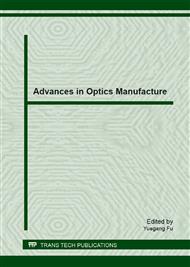p.3
p.8
p.14
p.21
p.27
p.33
p.38
p.44
Wide-Angle Behaviors of Sub-Wavelength Metal Gratings as Polarizing Beam Splitters
Abstract:
A second-order effective medium theory (second-order EMT) and thin film theory have been used to design a polarizing beam splitter (PBS) composed of one-dimensional sub-wavelength metal grating, considering the material of metal to be copper (Cu). It was analyzed by the finite difference time domain method for the wavelength of 1500nm. A high extinction ratio in transmission (>55.71dB) over abroad interval of angles of incidence ([-60o, 60o]) is achieved with the depth and the filling factor of the grating chosen to be 350nm and 0.3762, which are selected to transmit TM polarized light and reflect TE polarized light as much as possible at normal incident. The loss of the TE polarized light for the Cu structures is approximately less than 5.55% due to the absorption of Cu in a large angle range. The desired property will enable this type of polarizing beam splitter to be used in diverging beams. When the PBS needs to transmit approximately 25% of the TE polarized light and as much as possible the TM polarized light, it can be used in magneto-optical data storage head. But the depth of grating has been changed (approximately d=40nm) and TM transmission is only 94.7%. But it can be further improved (from 94.7% to 97.97%) by etching into the substrate.
Info:
Periodical:
Pages:
14-20
Citation:
Online since:
May 2013
Authors:
Price:
Сopyright:
© 2013 Trans Tech Publications Ltd. All Rights Reserved
Share:
Citation:


